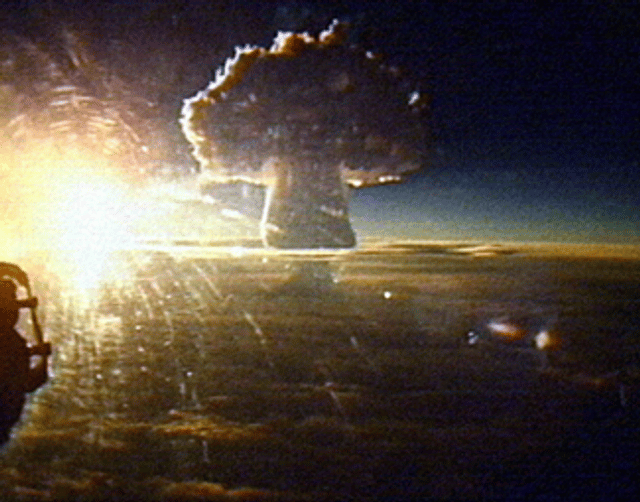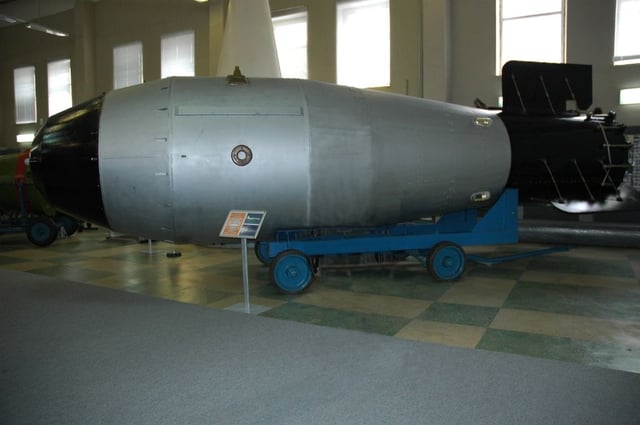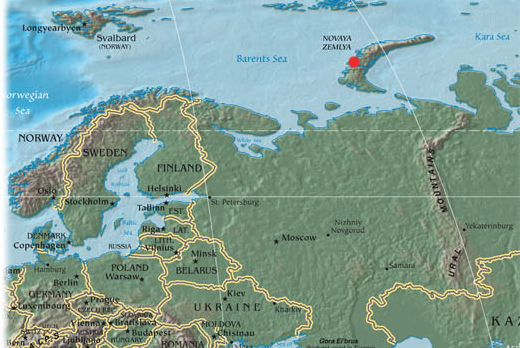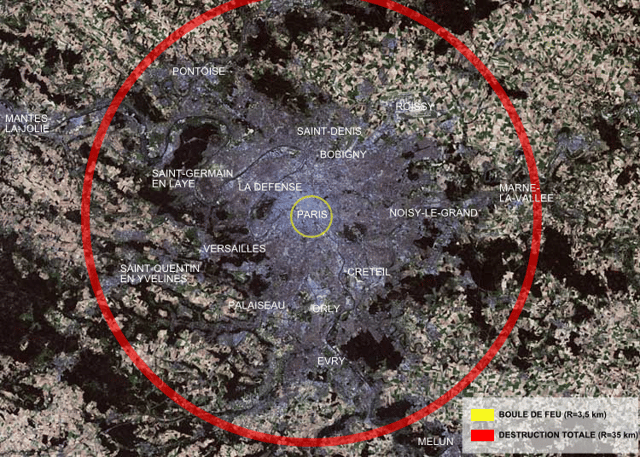Tsar Bomba

Tsar Bomba

| Tsar Bomba | |
|---|---|
| Type | Thermonuclear |
| Place of origin | |
| Production history | |
| Designer | Yulii Khariton, Andrei Sakharov, Victor Adamsky, Yuri Babayev, Yuri Smirnov, Yuri Trutnev, and Yakov Zel'dovich. |
| Manufacturer | |
| No. built | 2, only 1 was detonated |
| Specifications | |
| Mass | 27,000 kg (60,000 lb)[1] |
| Length | 8 m (26 ft)[1] |
| Diameter | 2.1 m (6 ft 11 in)[1] |
| Blast yield | 50 megatons of TNT (210 PJ)[2] |
The Soviet RDS-202 hydrogen bomb (code name Ivan[3] or Vanya), known by Western nations as Tsar Bomba (Russian: Царь-бо́мба, tr. Tsar'-bómba, IPA: [t͡sarʲ ˈbombə], lit. 'Tsar bomb'), was the most powerful nuclear weapon ever created. Tested on 30 October 1961 as an experimental verification of calculation principles and multi-stage thermonuclear weapon designs, it also remains the most powerful explosive ever detonated.
The bomb was detonated at the Sukhoy Nos ("Dry Nose") cape of Severny Island, Novaya Zemlya, 15 km (9.3 mi) from Mityushikha Bay, north of Matochkin Strait.[4][5][6] The detonation was secret but was detected by US Intelligence agencies. The US apparently had an instrumented KC-135R aircraft (Operation SpeedLight[7]) in the area of the test, close enough to have been scorched by the blast.[8][2]
The bhangmeter results and other data suggested the bomb yielded about 58 megatons of TNT [Mt] (240 PJ),[9] and that was the accepted yield in the literature until the Soviet scientists revealed that their instruments indicated a yield of 50 Mt (210 PJ) in 1991.[2] As they had the instrumental data and access to the test site, their yield figure has been accepted as more correct.[8][2] In theory, the bomb would have had a yield in excess of 100 Mt (420 PJ) if it had included a uranium-238 tamper, but because only one bomb was built, that capability has never been demonstrated.
The remaining bomb casings are located at the Russian Atomic Weapon Museum in Sarov and the Museum of Nuclear Weapons, All-Russian Research Institute of Technical Physics, at Snezhinsk.
| Tsar Bomba | |
|---|---|
| Type | Thermonuclear |
| Place of origin | |
| Production history | |
| Designer | Yulii Khariton, Andrei Sakharov, Victor Adamsky, Yuri Babayev, Yuri Smirnov, Yuri Trutnev, and Yakov Zel'dovich. |
| Manufacturer | |
| No. built | 2, only 1 was detonated |
| Specifications | |
| Mass | 27,000 kg (60,000 lb)[1] |
| Length | 8 m (26 ft)[1] |
| Diameter | 2.1 m (6 ft 11 in)[1] |
| Blast yield | 50 megatons of TNT (210 PJ)[2] |
Background
Name
Many codenames are attributed to the Tsar Bomba: Project 7000; product code 202 (Izdeliye 202), "Product V" (izdeliye V); article designations RDS-220 (РДС-220), RDS-202 (РДС-202), RN202 (PH202, incorrect codename as the AN602 is a modification of the RN202), AN602 (AH602); codename Vanya; nicknames Big Ivan, Kuzkina mat.[10][11] The name "Tsar Bomba" was coined in an analogy with other large Russian objects: the Tsar Bell and Tsar Cannon.[10] The CIA designated the test as "JOE 111".[6]
The bomb was also referred to as Kuzma's mother (Russian: Ку́зькина ма́ть, tr. Kúz'kina mát', IPA: [ˈkusʲkʲɪnə ˈmatʲ]),[12] possibly referring to First secretary Nikita Khrushchev's promise to "show the United States a Kuzma's mother" (an idiom roughly translating to "We'll show you") at a 1960 session of the United Nations General Assembly.[13][14]
Genesis

A Tsar Bomba-type casing on display at Sarov
In addition to being created for political, propagandistic use and as a response to the nuclear deterrence capabilities then possessed by the United States, the Tsar Bomba was created as part of the strategic nuclear forces concept of the USSR, adopted during the rule of Georgy Malenkov and Nikita Khrushchev, to achieve—without pursuing a quantitative parity with the US in terms of nuclear weapons and means of delivery—sufficient "guaranteed retaliation with an unacceptable level of damage to the enemy" in the event of a nuclear strike on the USSR via qualitatively superior nuclear power.
The "Malenkov-Khrushchev nuclear doctrine" involved the adoption of geopolitical and military challenges to the United States and the participation of the USSR in the nuclear race, but "in a distinctly asymmetrical style". The technical manifestation of this undocumented doctrine was the research-and-development of nuclear weapons and their means of delivery, the former large enough to completely (or nearly) wipe out large cities and entire urbanized regions in one strike (i.e. with a single payload and a single aircraft). An example of this would be the creation of the N-1 orbital combat rocket (GRAU index 11A52) per the Resolution of the Council of Ministers issued on 23 June 1960. With a starting weight of 2200 tons and a nuclear warhead weighing 75 tons, its estimated nuclear yield (though unknown exactly) could surpass that of a 150-ton-yield 40-ton warhead delivered by a UR-500 missile.
The development of such weapons also required mandatory and practical aerial bombardment methods, as for a high-yield (thermo-)nuclear explosion to reach maximal effect, the payload has to be detonated at an optimal height for the shock wave to reach the greatest force and range. In addition, ultra-large-yield thermonuclear bombs were considered by the Long Range Aviation units of the USSR, as their use fits the "cause the greatest damage to the enemy with a minimal number of carriers (i.e. bombers)" doctrine, while it was also necessary to consider the practical feasibility of such heavy thermonuclear weapons with reliably predictable characteristics. Before this, an underwater "doomsday weapon" considered by Soviet military and technical experts—essentially a giant torpedo launched by a dedicated nuclear submarine—was planned for development, which would detonate its nuclear warhead near the US coast, causing a huge tsunami. This project (known as the T-15 torpedo) was abandoned after more detailed consideration, as its combat effectiveness was questionable.
Design work on the Tsar Bomba started from autumn 1954[15] to autumn 1961 (with a two-year break from 1959-1960). A 100-megaton-of-TNT (420 PJ) nuclear bomb was also under development in NII-1011 at this time. This somehow contradicts partially with the official history of the institute (now the All-Russian Scientific Research Institute Of Technical Physics); the official history stated that the Ministry of Medium Engineering of the USSR order concerning the creation of a corresponding research institute was not signed until 5 April 1955, with design work starting a few months later. But in any case, there existed a common (but entirely false) myth that the Tsar Bomba was designed per personal order from Nikita Khrushchev with a total research and development time of only 112 days; the actual development of the final stage of the Tsar Bomba (then already placed in KB-11, now the All-Russian Scientific Research Institute of Experimental Physics) did indeed take 112 days.
The Tsar Bomba differs from its parent design—the RN202—in several places. The Tsar Bomba was a three-stage bomb with Trutnev-Babaev[16] second- and third-stage design,[17] with a yield of 50 Mt (210 PJ).[2] This is equivalent to about 1,570 times the combined energy of the bombs that destroyed Hiroshima and Nagasaki,[18] 10 times the combined energy of all the conventional explosives used in World War II,[19] one quarter of the estimated yield of the 1883 eruption of Krakatoa, and 10% of the combined yield of all nuclear tests to date. A three-stage hydrogen bomb uses a fission bomb primary to compress a thermonuclear secondary, as in most hydrogen bombs, and then uses energy from the resulting explosion to compress a much larger additional thermonuclear stage. There is evidence that the Tsar Bomba had several third stages rather than a single very large one.[20]
The initial three-stage design (coded A620EN, not tested) was capable of yielding approximately 100 Mt (420 PJ) through fast fission, 3,000 times the size of the Hiroshima and Nagasaki bombs,[21] but it was thought that it would have caused too much nuclear fallout, and the aircraft delivering the bomb would not have had enough time to escape the explosion. To limit the amount of fallout, the third stage and possibly the second stage had a lead tamper instead of a uranium-238 fusion tamper (which greatly amplifies the reaction by fissioning uranium atoms with fast neutrons from the fusion reaction). This eliminated fast fission by the fusion-stage neutrons so that approximately 97% of the total yield resulted from thermonuclear fusion alone (as such, it was one of the "cleanest" nuclear bombs ever created, generating a very low amount of fallout relative to its yield).[22] There was a strong incentive for this modification since most of the fallout from a test of the bomb would likely have descended on populated Soviet territory.[20][23]
The first studies on "Topic 242" began immediately after Igor Kurchatov talked with Andrei Tupolev (then held in autumn 1954). Tupolev appointed his deputy for weapon systems, Aleksandr Nadashkevich, as the head of the Topic. Subsequent analysis indicated that to carry such a heavy, concentrated load, the Tu-95 bomber carrying the Tsar Bomba needed to have its engines, bomb bay, suspension and release mechanisms seriously redesigned. The Tsar Bomba's dimensional and weight drawings were passed in the first half of 1955, together with its placement layout drawing. The Tsar Bomba's weight accounted for 15% the weight of its Tu-95 carrier as expected. The carrier, aside from having its fuel tanks and bomb bay doors removed, had its BD-206 bomb-holder replaced by a new, heavier beam-type BD7-95-242 (or BD-242) holder, attached directly to the longitudinal weight-bearing beams. The problem of how to release the bomb was also solved; the bomb-holder would release all three of its locks in a synchronous fashion via electro-automatic mechanisms, as required by safety protocols.
The CPSU Central Committee and the Council of Ministers of the USSR adopted a draft Joint Resolution on 12 March 1956 on the preparation and testing of izdeliye 202, which read:
Adopt a draft resolution of the CPSU Central Committee and the USSR Council of Ministers on the preparation and testing of izdeliye 202. Paragraphs required for inclusion in the draft resolution: a) The Ministry of Medium Engineering (Comrade Zavenyagin) and the Ministry of Defense of the USSR (Comrade Zhukov) at the end of the preparatory work for the test of izdeliye 202 to report to the CPSU Central Committee on the situation; b)The Ministry of Medium Engineering (Comrade Zavenyagin) to solve the issue of introducing a special stage of protection into the design of izdeliye 202 to ensure disarming of the product in the event of a failure of the parachute system, as well as their proposals reported to the CPSU Central Committee. Comrades Vannikov and Kurchatov are assigned to edit the final version of this resolution.
A Joint Resolution of the CPSU Central Committee and the Council of Ministers (Nr. 357-28ss) was issued on 17 March 1956, which mandated that OKB-156 begin conversion of a Tu-95 bomber into a high-yield nuclear bomb carrier. These works were carried out in the Gromov Flight Research Institute from May to September 1956. The converted bomber, designated the Tu-95V, was accepted for duty and was handed over for flight tests, which, including a release of a mock-up "superbomb", were conducted under the command of Colonel S. M. Kulikov until 1959, and passed without major issues.
Explosive components and lens were designed by a small team of Russian physicists led by Yulii Khariton that included Andrei Sakharov, Victor Adamsky, Yuri Babayev, Yuri Smirnov, and Yuri Trutnev. Shortly after the Tsar Bomba was detonated, Sakharov began speaking out against nuclear weapons, which culminated in him becoming a dissident.[4][23]
Test

Site of the detonation

The Tsar Bomba's fireball, about 8 km (5.0 mi) wide at its maximum, was prevented from touching the ground by the shock wave, but nearly reached 10.5 km (6.5 mi) altitude in the sky, the altitude of the deploying Tu-95 bomber
Despite the creation of the Tu-95V bomb-carrier aircraft, the actual test of the Tsar Bomba was postponed due to political reasons, namely Khrushchev's visit to the United States and a pause in the Cold War. The Tu-95V during this period was flown to Uzin (situated in today's Ukraine) and was used as a training aircraft, therefore it was no longer listed as a combat aircraft. With the beginning of a new round of the Cold War in 1961, the test was resumed. The Tu-95V had all connectors in its automatic release mechanism replaced, the bomb bay doors removed, and the aircraft itself covered with a special reflective white paint. Khrushchev himself personally announced the upcoming tests of the Tsar Bomba in his report at the 22nd Congress of the CPSU on 17 October 1961.
The Tsar Bomba was tested on 30 October 1961, flown to its test site by Major Andrei Durnovtsev. The Tu-95 bombers were designed to carry much lighter and smaller weapons (at maximum 27 tons after modernization[24]), meaning the Tsar Bomba was too big to be placed on a missile and too heavy for the planes to transport it to the target with enough fuel.[21]
Taking off from the Olenya airfield in the Kola Peninsula, the release plane was accompanied by a Tu-16 observer plane that took air samples and filmed the test. Both aircraft were painted with the special reflective paint to minimize heat damage. Despite this effort, Durnovtsev and his crew were given only a 50% chance of surviving the test.[10]
The bomb, weighing 27 metric tons, was so large (8 metres [26 ft] long by 2.1 metres [6 ft 11 in] in diameter) that the Tu-95V had to have its bomb bay doors and fuselage fuel tanks removed[1] (it is also larger than what the original layouts would suggest). The bomb was attached to an 800-kilogram (1,800 lb), 1,600-square-metre (17,000 sq ft) parachute, which gave the release and observer planes time to fly about 45 kilometres (28 mi) away from ground zero, giving them a 50 percent chance of survival.[21] The bomb was released two hours after takeoff from a height of 10,500 m (34,500 ft) on a test target within Sukhoy Nos. The Tsar Bomba detonated at 11:32 (or 11:33) Moscow Time on 30 October 1961, over the Mityushikha Bay nuclear testing range (Sukhoy Nos Zone C), north of the Arctic Circle over the Novaya Zemlya archipelago in the Arctic Ocean, at a height of 4,200 m ASL (4000 m above the target)[4][20][23] (some sources suggest 3,900 m ASL and 3,700 m above target, or 4,500 m). By this time the Tu-95V had already escaped to 39 km (24 mi) away, and the Tu-16 53.5 km (33.2 mi) away. When detonation occurred, the shock wave caught up with the Tu-95V at a distance of 115 km (71 mi) and the Tu-16 at 205 km (127 mi), and the Tu-95V dropped 1 kilometre (0.62 mi) in the air because of the shock wave but was able to recover and land safely.[10] According to initial data, the Tsar Bomba had a nuclear yield of 58.6 Mt (245 PJ) (significantly exceeding what the design itself would suggest), and was overestimated at values all the way up to 75 Mt (310 PJ).
The original, November 1961, United States Atomic Energy Commission estimate of the yield was 55–60 Mt (230–250 PJ). First secretary Khrushchev warned in a filmed speech to the Supreme Soviet of the existence of a 100-megaton bomb (technically the design was capable of this yield.)
Although simplistic fireball calculations predicted the fireball would hit the ground, the bomb's own shock wave reflected back and prevented this.[25] The 8-kilometre-wide (5.0 mi) fireball reached nearly as high as the altitude of the release plane and was visible at almost 1,000 km (620 mi) away from where it ascended.[26] The mushroom cloud was about 67 km (42 mi) high[27] (over seven times the height of Mount Everest), which meant that the cloud was above the stratosphere and well inside the mesosphere when it peaked. The cap of the mushroom cloud had a peak width of 95 km (59 mi) and its base was 40 km (25 mi) wide.[28][29]
All buildings in the village of Severny (both wooden and brick), located 55 km (34 mi) from ground zero within the Sukhoy Nos test range, were destroyed. In districts hundreds of kilometres from ground zero, wooden houses were destroyed, stone ones lost their roofs, windows, and doors, and radio communications were interrupted for almost one hour. One participant in the test saw a bright flash through dark goggles and felt the effects of a thermal pulse even at a distance of 270 km (170 mi). The heat from the explosion could have caused third-degree burns 100 km (62 mi) away from ground zero. A shock wave was observed in the air at Dikson settlement 700 km (430 mi) away; windowpanes were partially broken for distances up to 900 kilometres (560 mi).[30] Atmospheric focusing caused blast damage at even greater distances, breaking windows in Norway and Finland. Despite being detonated 4.2 km above ground, its seismic body wave magnitude was estimated at 5–5.25.[10][25] Sensors continued to identify the shockwaves after their third trip around the world.[11][31]
Immediately after the test, several U.S. Senators condemned the Soviet Union. Prime Minister of Sweden, Tage Erlander, saw the blast as the Soviets' answer to a personal appeal to halt nuclear testing that he had sent the Soviet leader in the week prior to the blast.[32] The British Foreign Office, Prime Minister of Norway Einar Gerhardsen, Prime Minister of Denmark Viggo Kampmann, and others also released statements condemning the blast. Russian and Chinese radio stations mentioned the American underground nuclear test of a much smaller bomb (possibly the Mink test) carried out the day prior, without mentioning the Tsar Bomba test.[33]
Analysis

Total destruction radius, superimposed on Paris. Red circle = total destruction (radius 35 kilometers), yellow circle = fireball (radius 3.5 kilometers).
The Tsar Bomba is the single most physically powerful device ever deployed on Earth.[34] For comparison, the largest weapon ever produced by the U.S., the now-decommissioned B41, had a predicted maximum yield of 25 megatons of TNT (100 PJ). The largest nuclear device ever tested by the U.S. (Castle Bravo) yielded 15 megatons of TNT (63 PJ) because of an unexpectedly high involvement of lithium-7 in the fusion reaction; the preliminary prediction for the yield was from 4 to 6 megatons of TNT (17 to 25 PJ). The largest weapons deployed by the Soviet Union were also around 25 megatons of TNT (100 PJ) (e.g., the SS-18 Mod. 3 warhead).
The weight and size of the Tsar Bomba limited the range and speed of the specially modified bomber carrying it. Delivery by an intercontinental ballistic missile would have required a much stronger missile (the Proton started its development as that delivery system). It has been estimated that detonating the original 100 Mt design would have released fallout amounting to about 26% of all fallout emitted since the invention of nuclear weapons.[35] It was decided that a full 100 Mt detonation would create too great a risk of nuclear fallout, as well as a near certainty that the release plane and crew would be destroyed before it could escape the blast radius.[36]
The Tsar Bomba was the culmination of a series of high-yield thermonuclear weapons designed by the Soviet Union and the United States during the 1950s (e.g., the Mark 17[37] and B41 nuclear bombs).[1]
Films
Footage from a Soviet documentary about the bomb is featured in Trinity and Beyond: The Atomic Bomb Movie (Visual Concept Entertainment, 1995), where it is referred to as the Russian monster bomb.[38] The video states that the Tsar Bomba project broke the voluntary moratorium on nuclear tests. In fact, Soviets restarted their tests and broke the unilateral voluntary moratorium 30 days before Tsar Bomba, testing 45 times in that month. Since the moratorium was unilateral there was no multilateral legal obstacle. The U.S. had declared their own one-year unilateral moratorium on nuclear tests, and as that year had expired, the US had already announced that it considered itself free to resume testing without further notice. Later it was stated that the U.S. had not resumed testing at the time of the Tsar Bomba test.[39] That announcement was in error, as the US had in fact tested five times under Operation Nougat between the USSR's ending of the moratorium on 1 October and the Tsar Bomba test on 30 October.
"World's Biggest Bomb", a 2011 episode of the PBS documentary series Secrets of the Dead produced by Blink Films & WNET, chronicles the events leading to the detonations of Castle Bravo and the Tsar Bomba.
Hoaxes and Myths
Test results of AN602 became the subject of rumors and hoaxes.
Some publications claimed that the bomb's power reached 120 megatons. This was probably due to the “overlay” of information about the excess of the actual explosion power over the estimated one by about 20% (in fact, by 14-17%) to the original design bomb power (100 megatons, more precisely 101.5 megatons). The newspaper Pravda added fuel to the fire of such rumors, on the pages of which it was officially stated that “she AN602 is the atomic weapon yesterday. Now even more powerful charges have been created.” In fact, the designers were considering the possibility of creating more powerful thermonuclear munitions (for example, the warhead of the UR-500 missile with a capacity of 150 megatons), but designs were developed no further.
At different times, rumors circulated that the bomb power was reduced by 2 times compared to the planned one, since scientists were afraid of a self-sustaining fusion reaction involving the atmosphere and the ocean in the hydrogen reaction and subsequent oxygen burnout. Before the test of the first atomic bomb in the United States, similar concerns were expressed about the occurrence of an uncontrolled nuclear reaction in the atmosphere, despite the contradiction of such a possibility to all known information about nuclear reactions. Just before that explosion, a young scientist who was nervous because of such fears was removed from the test site on the advice of doctors. In fact, detonation of neither the atmosphere nor the ocean is possible at any power of a thermonuclear explosion.
There is a rumor about the extremely rapid development of the Tsar Bomba, claiming that it was completely constructed 112 days after the commission of Khrushchev at the meeting on July 10, 1961. In fact, the development began in 1956.
This bomb was never some kind of labor gift from nuclear weapons developers to the opening of the next party congress, as some authors wrote.
See also
Father of All Bombs
GBU-43/B MOAB
Soviet atomic bomb project
Status-6 Oceanic Multipurpose System, rumored Russian thermonuclear-capable autonomous underwater vehicle, CIA code-named Kanyon

